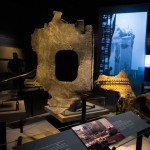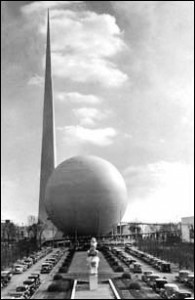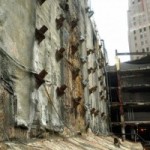 The article in today’s New York Times about the upcoming opening of the National September 11 Memorial Museum describes an architectural experience of the first order. Since buildings, or rather their destruction, are the objects around which the tangle of grief, anger, fear, personal loss and public outrage of 9/11 coalesced, this memorial presents a unique opportunity to explore and experience some of the many ways architecture can embody and express such emotions.
The article in today’s New York Times about the upcoming opening of the National September 11 Memorial Museum describes an architectural experience of the first order. Since buildings, or rather their destruction, are the objects around which the tangle of grief, anger, fear, personal loss and public outrage of 9/11 coalesced, this memorial presents a unique opportunity to explore and experience some of the many ways architecture can embody and express such emotions.
What role do the original intentions of the towers’ architects play in creating the meanings they now carry? Of course, the architects could not foresee the fate of their creation, but it is not by chance that the towers were targeted by the terrorists. A plaque near the entrance to the exhibits quotes architect Minoru Yamasaki to the effect that the towers represent “a monument to peace”, an excruciatingly ironic sentiment in light of their ultimate end and its consequences. Here is a first reminder to architects: communicating our intentions depends on contexts over which we have no control. The towers will go down in history, not as monuments to peace, but to pain, loss and national tragedy. Mr. Yamasaki’s benevolent intentions were inverted by history.
But of course an architect’s intentions depend for their intelligibility on the form and material of the building, as well as its relationship to its surroundings. The raw fact of the design was that it consisted of two enormous identical towers set in a vast open space. Peaceful or no, everything about the design proclaimed the triumph of post-industrial capitalism. They were the tallest buildings in the world at the time of their completion, a quantitative superlative that also bespoke the mastery of their engineering (which contributed tragically to their collapse). They occupied an enormous piece of the world’s most expensive real estate for no other purpose than to set them apart from the city. Unlike many of their New York precedents, they were starkly rectangular, asserting a belief in the power of pure geometric forms to elicit a universal response. This was a commonplace among architects of the Modern Movement, carried to an extreme. And there were two of them, doubling down on the claim of universality. No trylon-and-perisphere dialectic here: there was only one idea to represent.
Modern Movement, carried to an extreme. And there were two of them, doubling down on the claim of universality. No trylon-and-perisphere dialectic here: there was only one idea to represent.
It is doubtful that the architects developed their design deliberately to communicate these ideas. Nevertheless, such ideas were part of the intellectual equipment most architects of the time carried, often cloaked in ideology. And whether or not the terrorists who destroyed the towers thought in these terms, the potency of the towers’ symbolic representation of capitalist triumphalism made them the perfect target. What more powerful expression of their hatred of modern Western civilization could the terrorists have found?
If Yamasaki and his collaborators set out explicitly to make an enduring symbol of Western capitalism, they clearly succeeded. It seems more likely, though, that they were expressing ideals that they felt were implicit in the building’s program (peace, freedom, etc.) Architects tend to deal in positives, since the effort of building seems justified only if the ends are beneficial. So it appears that the architects’ intentions that made the World Trade Center the complex and powerful symbol that it has become were not exactly what they were thinking about, although not far from the surface. If nothing else, this is a reminder to architects that they need to examine their thinking critically and understand what truly motivates their intentions. But try as they might, some of their intellectual and emotional apparatus is bound to remain obscure to them. After all, Yamasaki et al. were attacked on 9-11 with the rest of us.
The wealt h meanings of 9/11 holds for millions of people have the physical site as their nexus. It appears the architects of the memorial were wise enough to understand the power of the artifacts they had before them to build their design around them. A portion of the towers’ exterior wall plays an important role in the design of the museum. Perhaps even more interesting is the fact that the concrete slurry retaining wall (image at right) that protects the site from being flooded by the Hudson River has taken on an equal if not greater significance. Why? This wall was never meant to be seen. It was a purely functional piece of civil engineering that the architects probably paid very little attention to and certainly never considered as part of their design. When the towers collapsed, however, the slurry wall stood, soldiering on, so to speak, after the towers fell. All was not lost: the site remained, the wall permitted its rebuilding and sanctification as testimony to our collective strength and wisdom. The elevation of this humble wall to iconic status should remind architects that the act of building in itself is always an expression of human will; any built object can register history and acquire meaning as a record of humanity’s trials and triumphs. The intention of building itself is easily overlooked because it is always present. One of the purposes of architecture is to ensure that it is felt.
h meanings of 9/11 holds for millions of people have the physical site as their nexus. It appears the architects of the memorial were wise enough to understand the power of the artifacts they had before them to build their design around them. A portion of the towers’ exterior wall plays an important role in the design of the museum. Perhaps even more interesting is the fact that the concrete slurry retaining wall (image at right) that protects the site from being flooded by the Hudson River has taken on an equal if not greater significance. Why? This wall was never meant to be seen. It was a purely functional piece of civil engineering that the architects probably paid very little attention to and certainly never considered as part of their design. When the towers collapsed, however, the slurry wall stood, soldiering on, so to speak, after the towers fell. All was not lost: the site remained, the wall permitted its rebuilding and sanctification as testimony to our collective strength and wisdom. The elevation of this humble wall to iconic status should remind architects that the act of building in itself is always an expression of human will; any built object can register history and acquire meaning as a record of humanity’s trials and triumphs. The intention of building itself is easily overlooked because it is always present. One of the purposes of architecture is to ensure that it is felt.
The deeper, enduring meanings of the attacks on the World Trade Center and their aftermath are perhaps clearer in the architectural artifacts than anywhere else. The remains of the original structures, the new memorial museum and park, as well as the Freedom Tower, form a group that must be read in its ensemble with an understanding of the physical, social, political and economic factors that surround and condition any building. Architecture clears away the obfuscations of politics and power to reveal what is essential: human life in all its complexity, recorded in exquisite detail.


